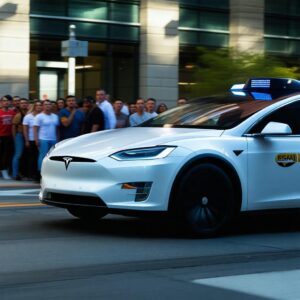
GM Abandons Robotaxi Program, Leaving Jobs and Future Uncertain
A Sudden and Unexpected Decision
In a shocking move that has sent shockwaves throughout the automotive industry, General Motors (GM) has announced its decision to end its robotaxi program, Cruise. The news was revealed in a Slack message from Cruise CEO Marc Whitten, with no prior warning or explanation. This sudden and unexpected decision has left employees at Cruise uncertain about their job security, and raises questions about the future of autonomous driving development at GM.
A Brief History of Cruise
Cruise, which was acquired by GM in 2016, had been working towards commercializing robotaxis for several years. The company’s ambitions were initially projected to reach tens of thousands of custom-built Origin robotaxis on the road by 2025. However, Cruise has faced numerous setbacks, including a permit loss in California following an incident involving one of its robotaxis. Despite these challenges, GM had continued to invest heavily in Cruise’s development, with plans to launch a driverless service in Houston in 2025.
The Decision and Its Implications
The decision to end the robotaxi program marks a significant pivot for GM, which has been under pressure to commercialize its autonomous driving technology. The company had been expected to generate revenue from its robotaxi service, but this move suggests that it may be refocusing its efforts on personal vehicles instead. This shift in strategy raises questions about the future of autonomous driving development at GM and whether this move signals a shift away from commercialization efforts.
Employee Concerns
Employees at Cruise were left uncertain about their job security following the announcement. During an all-hands meeting, executives provided little information about potential layoffs, but several employees expect cuts, particularly among non-engineering roles and those related to robotaxi operations. This uncertainty has created a sense of unease among employees, who are now waiting anxiously for further information from management.
A Reflection of Industry Challenges
The decision by GM to end its robotaxi program reflects the challenges that the autonomous driving industry is facing. Despite significant investment and innovation, companies have struggled to commercialize their technology and generate revenue. The setback in California, which led to a permit loss for Cruise, is just one example of the regulatory hurdles that companies must overcome in order to deploy their autonomous vehicles on public roads.
A Shift Away from Commercialization?
The decision by GM to end its robotaxi program raises questions about whether this move signals a shift away from commercialization efforts. If GM is indeed refocusing its efforts on personal vehicles, it may be abandoning its ambitions for widespread adoption of autonomous driving technology. This would have significant implications for the industry as a whole, and could potentially slow down the development of autonomous vehicles.
Speculating About the Future
It is difficult to predict what the future holds for GM’s autonomous driving program following this decision. However, it is likely that the company will continue to invest in its personal vehicle business, which has been a core part of its strategy for many years. The question remains whether GM will eventually return to its ambitions for commercialization of robotaxis, or if it will abandon this effort altogether.
Conclusion
The sudden and unexpected decision by GM to end its robotaxi program has left employees at Cruise uncertain about their job security and raises questions about the future of autonomous driving development at GM. This move reflects the challenges that the industry is facing in commercializing its technology and generating revenue. While it is difficult to predict what the future holds, one thing is certain: this decision will have significant implications for the automotive industry as a whole.
Key Takeaways
- GM has decided to end its robotaxi program, Cruise
- Employees were left uncertain about their job security
- Potential layoffs are expected, particularly among non-engineering roles
- The decision marks a significant pivot for GM’s autonomous driving development
- The future of autonomous driving development at GM is unclear







Are you kidding me, Iker? You’re comparing the robotaxi program to flake sightings in North Carolina? Meanwhile, NASA is teaming up with the Astronomical League for the Hubble Night Sky Challenge. Clearly, GM is ahead of the curve, preparing us for an era where self-driving cars can navigate through a snowstorm while simultaneously taking selfies with a stunning view of the galaxy. It’s called innovation, bro!
I agree with Kaiden that General Motors may be pivoting to a new business model by combining their autonomous driving capabilities with other technologies such as electric vehicles or urban planning, which could potentially benefit the industry as a whole; however, I have to ask Timothy, how can you confidently say GM is at the forefront of innovation when there’s been no concrete evidence presented about their self-driving cars navigating through snowstorms while taking selfies with a view of the galaxy?
I generally agree with Seth and Kaiden’s insights on the strategic reorientation of GM towards integrating autonomous tech with other sectors, yet I find Marley’s speculation about undisclosed projects like NASA collaborations intriguing, though perhaps a bit far-fetched. However, Seth, considering your background in the automotive industry, how do you view the balance between transparency and strategic secrecy in such a volatile market? And Marley, what makes you think GM would venture into such diverse fields as autonomous delivery drones?
because who needs all that paperwork and regulatory drama? On a more serious note, I can only imagine how tough it must be for the folks at Cruise to see their dreams of robotaxis abandoned. As someone in the industry (I work with self-driving tech), I’ve seen firsthand how challenging commercialization is. But hey, maybe GM will shift its focus to personal vehicles and make us all the happier for it? The question remains: what’s next for autonomous driving development at GM?